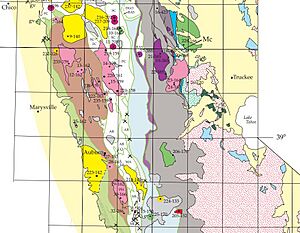Smartville Block facts for kids
The Smartville Block is a special piece of land in California. It's also called the Smartville Ophiolite or Smartville Complex. This land was once part of the ocean floor and a chain of volcanoes under the sea, like a volcanic island arc. About 160 to 150 million years ago, during the late Jurassic period, this piece of land crashed into and joined the North American Plate.
When these two huge land masses collided, it created a lot of heat deep underground. This heat warmed up water that was full of minerals. This hot, mineral-rich water then moved up through cracks in the rocks. As the water cooled, minerals like gold settled out and formed deposits. The Smartville Block is found in the foothills of the Sierra Nevada mountains in northern California. It stretches west, even going under parts of the Central Valley and the California Coast Ranges. The rocks here are a type called an ophiolite. Ophiolites are pieces of the ocean's crust and upper part of the Earth's mantle that have been pushed onto land. Scientists study ophiolites to understand how plate tectonics works and how Earth's crust moves.
Why is the Smartville Block important for gold?
Gold was first found in California in the mid-1800s, leading to the famous California Gold Rush. The Smartville Block is named after a small Gold Rush town called Smartville in Yuba County.
The gold found in the Smartville Block and nearby areas was formed by a process called "hydrothermal" activity. Here's how it worked:
- Water deep underground gets heated by the Earth's warmth.
- This hot water picks up minerals, including gold, from the surrounding rocks.
- The collision that formed the Smartville Block created many cracks and faults in the rocks.
- The hot, mineral-rich water then flowed up through these cracks.
- As the water moved closer to the surface, it cooled down.
- When the water cooled, the gold and other minerals could no longer stay dissolved. They settled out and formed deposits, often in long, thin shapes called veins.
The eastern edge of the Smartville Block is marked by a major fault zone called the Rescue Lineament-Bear Mountains fault zone. This area generally shows where many of the gold-rich veins of the Mother Lode region are found. This region was very important during the California Gold Rush.
What kind of rocks are in the Smartville Block?
The Smartville Ophiolite is made of different types of rocks, depending on how deep they were formed. Think of it like layers, from the top down:
- Upper Volcanic Unit: This is the top layer. It has rocks that look like stacked pillows, called pillow lava, which form when lava erupts underwater. There are also large, solid lava flows. You can also find rocks called turbidites here, which are formed from underwater landslides. These turbidites are often made of a type of siliceous rock and can have sandstone and conglomerate on top.
- Lower Volcanic Unit: Below the upper unit, this layer also has a lot of pillow lava and broken rock pieces called breccia. It also contains rocks that pushed their way into existing rocks. Some of these rocks are tuffaceous, meaning they are made from volcanic ash.
- Dike Complex: This layer is made of many flat, wall-like rock formations called dikes. These dikes are made of volcanic rocks like dacite and rhyolite. They cut through the rocks of the lower volcanic unit.
- Plutonic Suite: This is the deepest layer. It's made of rocks that cooled slowly deep underground, like gabbro and diorite. These rocks are also cut by dikes and by larger masses of granite from an ancient mountain-building event called the Nevadan Orogeny.
Images for kids



